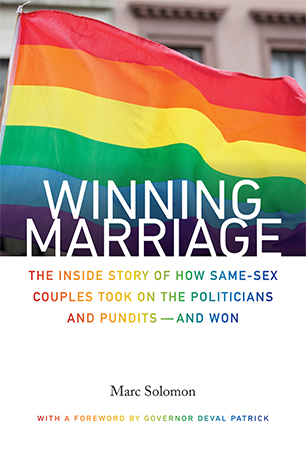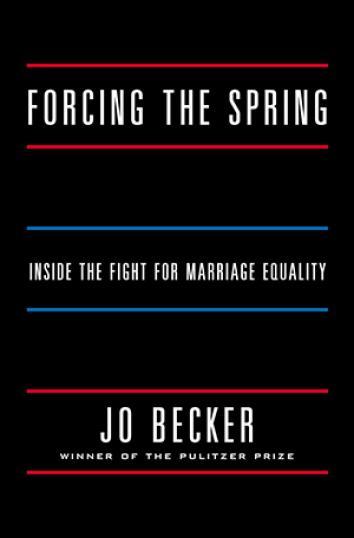The race to write a triumphal history of the struggle for marriage equality for lesbians and gay men has begun. During 2014, publishers released two substantial books tracing the recent past. In the spring, Jo Becker's Forcing the Spring debuted with much fanfare and press attention. This fall, Marc Solomon's Winning Marriage entered bookstores with somewhat less attention, a shame because Winning Marriage is by far a superior book. While both of these books provide an emergent history, much of the history of marriage equality remains to be written. History, like science, is "a cumulative process."
In Winning Marriage, Solomon organizes his narrative around four main struggles for marriage recognition. He begins in Massachusetts where he worked with the Massachusetts Freedom to Marry Coalition as a volunteer and paid lobbyist. The narrative that Solomon provides from the moment of the court decision to the final vote by the legislature to not amend the constitution prohibiting lesbians and gay men from marrying is fast-paced and compelling. Solomon profiles state legislators, gay and lesbian couples and activists demonstrating grassroots support for the law and documenting the extensive organizing efforts to secure marriage in the first state with the freedom to marry.
Solomon then continues with the story of securing marriage equality through the legislature in New York and winning at the ballot boxes, with particular attention to Maine, Minnesota and Washington. He concludes with President Barack Obama's evolution on marriage and the U.S. Supreme Court decision in Windsor.
Solomon is an engaging narrator throughout the book, never too intrusive. He consistently provides compelling and interesting detail while keeping the narrative moving forward. Most impressive in Winning Marriage is its commitment to recognizing multiple people -- activists, legislators, lobbyists and just plain interested citizens -- and their role in the struggle for marriage equality. In Solomon's hands, the story of marriage equality is multi-vocal, even cacophonous, with an array of people working with commitment to achieve the goal.
This characterization is, of course, in sharp contrast to Becker's narrative in Forcing the Spring. Becker, a Pulitzer-prize winning, New York Times journalist selected an elite group of white men to be the focus of her narrative, thinking that they would certainly be the people to lead the historic change. Through Forcing the Spring, Becker seeks to lionize Chad Griffin by placing him alongside legal lions, Ted Olson and David Boies. Of course, it was not their case against Proposition 8 that was the winner at the Supreme Court -- it was the case of Robbie Kaplan litigating on behalf of Edie Windsor. Similarly, Becker's narrative to lionize Griffin fails.
Forcing the Spring is organized into four parts, pivoting around what Becker imagines as a dynamic and dramatic court case. She even alludes to the Scopes monkey trial to situate the historic significance of the case. The first section of Forcing the Spring chronicles the lead up to the trial, including the assembly of the cast of characters, which in comparison to Solomon's rich story is paltry. Most striking is how ungenerous Becker is to LGBT activists; her derisive characterizations of movement activists is both mean-spirited and fails to recognize the multiple elements necessary for social movement success. The second section is a day-by-day recap of the trial and, much like the HBO film, The Case Against 8, a dry and boring experience. It takes great artistry to make art out of trials.
The third and fourth sections of Forcing the Spring open further, almost into an interesting narrative. After the district court trial, the political environment heats up for marriage, and Becker looks outside of the single case providing interesting history about Obama's evolution and the myriad of options the Appellate and Supreme Courts had with the case.
At one point, Becker almost seems to recognize the differences between the Proposition 8 case and the Windsor case, writing, "The teams were as different as could be. The Proposition 8 team was led by two straight men; Kaplan's was predominantly female, and led by three lesbians" (361). It is almost as if she can see a broader community working on marriage equality but not quite. Becker continually focuses narrowly on her selected, elite subjects, resulting in a book that ultimately feels short-sighted, narrow, and unreliable.
If journalism is a first draft of history, the movement for marriage equality deserves many more drafts quickly. While Solomon's Winning Marriage is rich, certainly there are other stories still to be told. When a more comprehensive history has been drafted, Becker's Forcing the Spring can wrap day-old fish.


